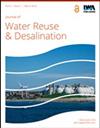抗生素耐药细菌和基因的命运和持久性通过多屏障处理设施直接饮用再利用
IF 2.3
Q2 Environmental Science
引用次数: 15
摘要
由于有安全饮用水的技术解决办法和指导方针,再生水的直接饮用再利用已成为克服干旱地区严重缺乏饮用水的一个有希望的选择。然而,随着人们对相应原料废物中存在抗生素耐药菌(ARB)和抗生素耐药基因(ARG)的认识不断提高,引发了新的安全问题。本研究调查了纳米比亚温得和克先进水处理设施每个处理步骤后ARB和细胞内及细胞外ARG的命运。新Goreangab水回收厂(NGWRP)从国内二级污水处理厂的废水中生产饮用水,并直接提供温得和克大约四分之一的饮用水需求。研究耐药决定因素的方法是基于分子生物学和基于培养的微生物学方法。采用TaqMan real-time PCR检测并定量胞内耐药基因sul1、ermB、vanA、nptII、nptIII以及胞外耐药基因sul1。NGWRP将最终产品中可培养细菌指标和抗性基因的数量降低到低于检测极限的水平。主臭氧氧化法和超滤法对两个决定因素的去除率最高。本文章由计算机程序翻译,如有差异,请以英文原文为准。
Fate and persistence of antibiotic-resistant bacteria and genes through a multi-barrier treatment facility for direct potable reuse
Given the availability of technological solutions and guidelines for safe drinking water, direct potable reuse of reclaimed water has become a promising option to overcome severe lack of potable water in arid regions. However, the growing awareness of the presence of antibiotic-resistant bacteria (ARB) and antibiotic resistance genes (ARG) in corresponding raw wastes has led to new safety concerns. This study investigated the fate of ARB and intracellular and extracellular ARG after each treatment step of an advanced water treatment facility in Windhoek, Namibia. The New Goreangab Water Reclamation Plant (NGWRP) produces drinking water from domestic secondary wastewater treatment plant effluent and directly provides for roughly a quarter of Windhoek's potable water demand. Procedures to study resistance determinants were based on both molecular biology and culture-based microbiological methods. TaqMan real-time PCR was employed to detect and quantify intracellular resistance genes sul1, ermB, vanA, nptII and nptIII as well as extracellular resistance gene sul1. The NGWRP reduced the amount of both culturable bacterial indicators as well as the resistance genes to levels below the limit of detection in the final product. The main ozonation and the ultrafiltration had the highest removal efficiencies on both resistance determinants.
求助全文
通过发布文献求助,成功后即可免费获取论文全文。
去求助
来源期刊

Journal of Water Reuse and Desalination
ENGINEERING, ENVIRONMENTAL-WATER RESOURCES
CiteScore
4.30
自引率
0.00%
发文量
23
审稿时长
16 weeks
期刊介绍:
Journal of Water Reuse and Desalination publishes refereed review articles, theoretical and experimental research papers, new findings and issues of unplanned and planned reuse. The journal welcomes contributions from developing and developed countries.
 求助内容:
求助内容: 应助结果提醒方式:
应助结果提醒方式:


